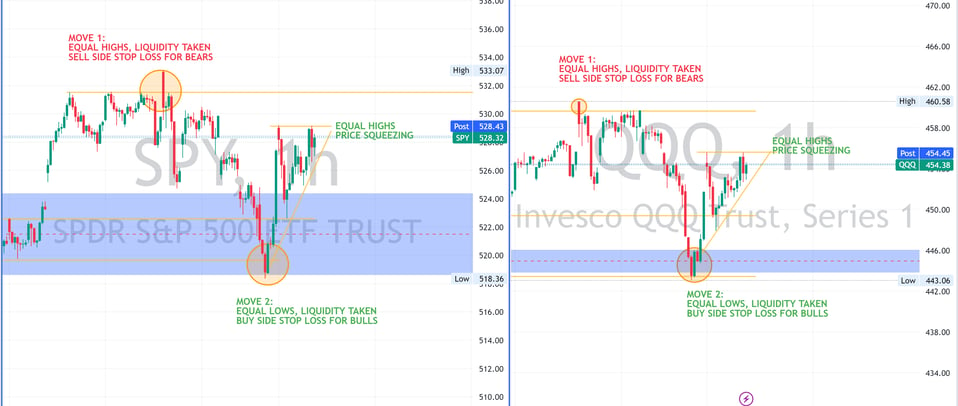Market Review 04th June 2024
Simplify the craziness
DAILY REVIEW
N
3 min read
Wall Street saw a modest recovery on Tuesday, with the Dow Jones Industrial Average rising as investors navigated an uneven start to June. Key economic indicators, employment data, and sector performance drove market movements. This article provides a detailed analysis of the day's events, with insights into broader economic trends and the implications for future market behavior.
Key Market Movements
Dow Jones Industrial Average
The Dow Jones Industrial Average (DJIA) gained 140.26 points, or 0.36%, closing at 38,711.29. This uptick followed Monday's decline, as investors sought to stabilize amidst mixed economic signals.
S&P 500 and Nasdaq Composite
The S&P 500 and Nasdaq Composite also posted gains. The S&P 500 added 0.15% to finish at 5,291.34, while the Nasdaq Composite advanced 0.17% to 16,857.05. These increases were supported by gains in technology and consumer staples stocks, despite notable losses in energy and materials sectors.
Sector Highlights
Technology and Consumer Staples
Technology stocks, including Amazon, Alphabet, Nvidia, and Microsoft, ended higher after an early-session dip. Consumer staples also saw advances, contributing to the overall positive movement of the indexes.
Energy and Materials
Energy stocks were among the day's biggest losers, with Exxon Mobil and Chevron falling 1.6% and 0.8%, respectively. Materials stocks also struggled, reflecting broader concerns about global economic growth and demand.
Notable Declines
Bath & Body Works was the worst-performing stock in the S&P 500, losing nearly 13% due to disappointing guidance. Other significant decliners included Axos Financial, which dropped after Hindenburg Research disclosed a short position, and Paramount Global, which fell 4.4% after announcing it was exploring strategic options for its streaming service.
Economic Indicators and Investor Sentiment
Employment Data
The Labor Department reported 8.059 million job vacancies in April, the lowest level in over three years, missing the Dow Jones estimate of 8.4 million openings. This data, along with recent weak manufacturing figures, suggests a cooling labor market and broader economic slowdown.
Treasury Yields and Rate Cut Expectations
Treasury yields were notably lower, with the 10-year note slipping about 7 basis points. Traders now see a nearly 62% likelihood of two rate cuts this year, up from 36% a week ago, according to the CME FedWatch Tool. However, some experts, like Megan Horneman of Verdence Capital Advisors, express skepticism about the Fed's willingness to cut rates due to persistent inflation, particularly in the services sector.
Global Market Reactions
Emerging markets experienced significant volatility due to political developments. Mexico's peso and South Africa's rand continued to slide following election surprises, while India's equity markets swooned almost 6% on Tuesday after it became apparent that Prime Minister Narendra Modi might lose his majority.
Insights from Market Analysts
Megan Horneman highlighted the market's need for a catalyst, noting, "There's going to come a point where the bad news is actually bad news." This sentiment reflects the delicate balance investors seek: a labor market weak enough to justify rate cuts but not so weak that it raises recession fears.
James St. Aubin from Sierra Mutual Funds pointed out that recent economic data has been weak, helping bond market rallies but presenting a double-edged sword for equities. He noted that the likelihood of a rate cut has increased with weaker data, but the stock market's response remains mixed.
Looking Ahead
Nonfarm Payrolls Report
Investors are keenly awaiting Friday's nonfarm payrolls report for May. This data will provide crucial insights into the labor market's health and could significantly influence the Federal Reserve's monetary policy decisions.
Political and Economic Risks
Political risks remain a significant concern, especially in emerging markets. Analysts caution that further volatility could arise as political events unfold, with upcoming U.S. elections being a critical factor to watch. The potential for renewed trade tariffs and other policy changes underlines the importance of political risk assessment in market analysis.
Conclusion
Tuesday's trading session highlighted Wall Street's search for stability amidst mixed economic signals and ongoing political uncertainties. While the Dow, S&P 500, and Nasdaq managed to post gains, the market remains sensitive to upcoming economic data and geopolitical developments. Investors should stay informed and cautious as they navigate these complex dynamics.
References
Dow rises on Tuesday - CNBC
Labor Department Job Openings Report - U.S. Bureau of Labor Statistics
CME FedWatch Tool - CME Group
Emerging Markets Reaction - Reuters
Sector Performance - MarketWatch


